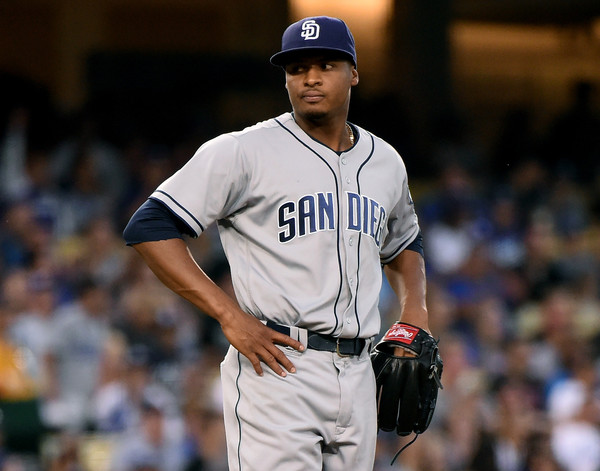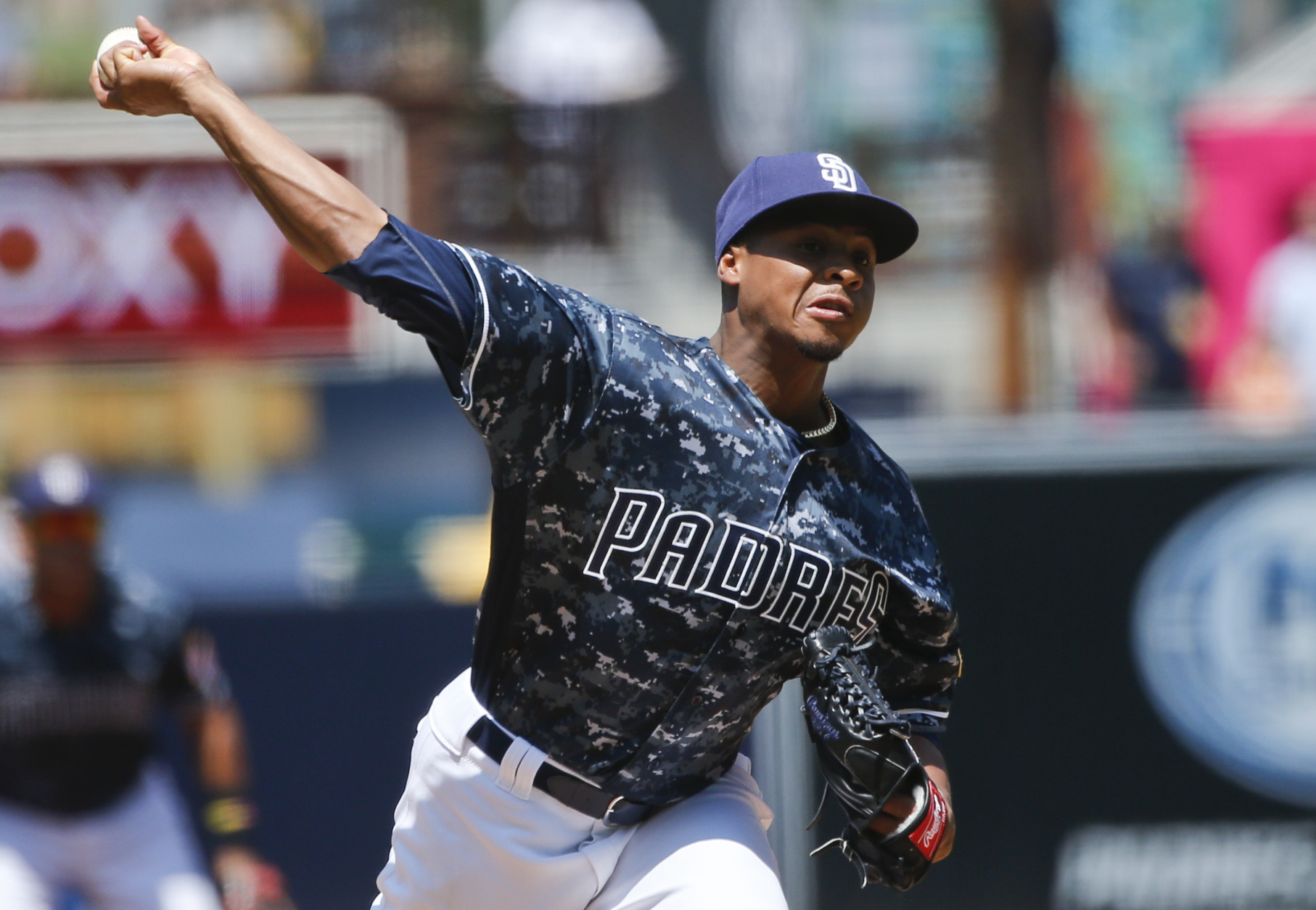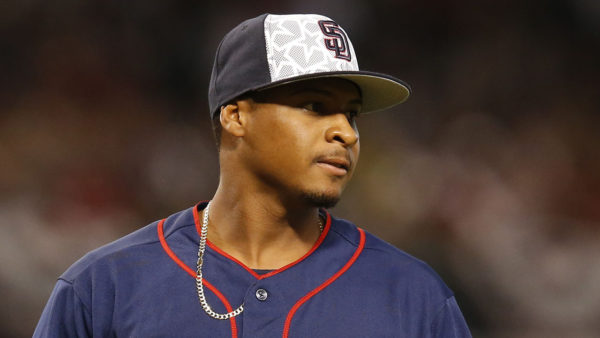PNO (Positive, Negative, Outlook): Luis Perdomo


When the San Diego Padres traded for a 22-year-old, recently Rule 5 draft-selected pitcher, no one expected the kid to succeed in the majors.
It was a surprise then that the former Cardinal, Luis Perdomo, would go on to provide 146.2 meaningful innings for the Friars and be granted the right to stay in America’s Finest City.
Coming into 2017, he was seen as one of the team’s biggest X-factors, a potential middle-of-the-rotation starter. However, it was irrational to think that he could become the ace of the staff this year, even with a very shallow rotation.
Is he a long-term fixture for the Padres, though?
To predict his future with the club, it’s best to evaluate Perdomo’s positive and negative traits and then make a reasonable conclusion from that (outlook).
Here is EVT’s latest PNO. This time on prized right-handed hurler, Luis Perdomo.
Positives
Workhorse Mentality
Before coming to San Diego, the most starts Perdomo had in a year was 22 with the Peoria Chiefs (A) and Palm Beach Cardinals (A+) in 2015. He nearly eclipsed that in his first year of major league ball while also playing the role of reliever 15 times. As a result, he accumulated 20 more innings than ever before and did so at the highest level. This was a great development due to the sheer youth of Perdomo and the inexperience he carried.
But considering how damaging a heavy workload is to a starter, think Jake Arrieta‘s and Corey Kluber‘s early 2017 results, it was even more amazing how he was able to stay fresh over an additional 17 frames in 2017. These numbers add up to a ratio of 5.63 innings pitched per game, a good number for a player who has had to make a quick transition to the major league level. In short, he has a bulldog attitude, ready to take the ball every fifth day and compete. There’s no reason to expect Andy Green to hold him back next year. He could very well approach 200 innings next season, especially with more service time under his belt.
Ground-ball Artistry
Many of the starters on San Diego’s roster were pitchers who relied on keeping the ball on the ground. They didn’t have the potential for gaudy strikeout numbers like Max Scherzer, but still made smart usage of their arsenal to keep the ball in play. While Clayton Richard might have been the Padres’ most effective pitcher at letting his infield play, Luis Perdomo was no slouch in this area either. In fact, he was the fifth-most valuable MLB starter when it came to forcing ground balls.

According to ESPN, he also had the third-best GB/FB mark among starters with at least 100 innings pitched. During his 2017 season, he induced 1.66 balls hit on the ground per every one swatted in the air. With such effectiveness, Perdomo proved to be a reliable asset to the team. He wasn’t especially successful at run production, 4.67 ERA; however, he was able to stay in the rotation as a result of the type of contact he allowed.
Improving Results
As previously stated, it was a pleasant surprise that Luis Perdomo proved to be a valuable starter in 2016. By all accounts, he shouldn’t have been able to skip both Double-A and Triple-A and make himself a long-term option for San Diego. He kept showing merit this year and advanced beyond his prior numbers. His improvement from 2016 to 2017, including a decrease in ERA, from 5.71 to 4.67, HR/9, from 1.4 to .9, and FIP, from 4.84 to 4.40, as well as an increase in ERA+, from 70 to 88, and overall WAR, from 0.2 to 1.6 were notable. They were exceptional signs for a young contributor and point to a long-term starter’s profile. Yet, don’t be surprised if Perdomo takes more steps forward in 2018 as he has certainly shown that he can get better with more time and exposure to the best hitters.
Negatives
Too Many Short Outings
Although 29 games started is an excellent achievement, the amount of quality starts that Perdomo had was too few. In total, the 24-year-old completed only 16 games where he threw at least six innings and surrendered only three runs. This comes out to a 55.17% success rate, a figure that definitely needs improvement if Perdomo hopes to be in San Diego’s stacked rotation of the future (Gore, Morejon, Quantrill, Lauer, Baez, Luchessi, Allen, etc.). Moreover, he pitched fewer innings than the amount of runs he gave up three times and allowed at least four opposing players to reach home plate eight times. On May 20, the Dominican’s game really blew up as the Arizona Diamondbacks scored eight times in just three frames.
Another similar situation was on July 17, when the Padres faced off against the Rockies, and Colorado coasted to a five to two lead in 2.1 innings against Perdomo. This inability to go deep into games was not a recipe for success on a team that hosted MLB’s least potent offense in important stats such as batting average, .234, on-base percentage, .299, and runs, 5356. In short, Perdomo had several outings where he cost San Diego the game in a matter of a few innings. He sometimes didn’t deliver and essential hitters such as Wil Myers, Manuel Margot, and Hunter Renfroe couldn’t pick up the slack. If Perdomo desires a key role in the next championship team, he must limit the number of bad starts he has. Yet he did ascend the minor league ranks in a massive rush so there should be a long leash attached to him.
Low K rate/High BB figures
It’s disappointing how inept Luis Perdomo has been at mowing hitters down. He came up with a stellar fastball (65-grade)/slider (55-score) combination, but has yet to show it. His strikeout rate has therefore been a minor factor as only six and a half opposing batters have gone down on strikes. Often pitchers can survive with this low whiff capability by countering it with precise command.

Yet, the more time Perdomo has had in the majors to adjust, the more he has demonstrated how scouts were wrong in labeling his command as average. In 2016, he had a walk rate of 2.8 per nine, a manageable figure, and this year he exemplified much worse control by issuing 3.6 free passes/9. As a result, his WHIP and SO/W numbers were unpleasant, standing at 1.509 and 1.82 respectively. Such failure will not make a favorable impression on the front office. Perdormo must do better to stay in Preller’s good graces. Even lowering the walks and upping the strikeouts by a small variance will help the young man prevent scoring. It will also set him up for a continuation of opportunity.
Boring
This is definitely a more subjective claim, but to me, Perdomo is quite disenchanting. His low K rate, ground ball inducing habit, and mediocre ERA will do that. Yet, so will the fact that whenever the starter was interesting in the news, it was when he was on offense. Most of the thrill that came from watching San Diego’s Rule 5 jackpot came from his hitting. On June 13, he became the first pitcher to hit two triples in a season since Florida Marlin Dontrelle Willis accomplished the feat in 2007. On October 1, Perdomo tied MLB history for a pitcher by hitting four triples in one year, a task also completed by Philadelphia Philly Robin Roberts in 1955. These were all huge stories on Padres pages. Above all pitching performances, Perdomo’s most riveting exhibitions were usually on offense, not defense, where he makes a mainstay.
Outlook
2017 showed how far off Perdomo is from being a finished product. He’s adjusted more to the league than last year and the results have been proof. Yet, the young righty still needs to aim for more consistency next year even though he’s been a workhorse so far. An uptick in K’s and decrease in ERA are some more areas for the Friar to progress in. If not, expect him to be relegated to the bullpen as enthralling new starters from the minors start appearing. However, don’t expect an ace out of the former Cardinal as he just doesn’t have the tools to be one. His ceiling is more of a back-end-type starter. Either way, expect a useful contributor in the upcoming years.
I write, I write, and then I write some more.. Lifelong Padres & Chargers fan who is tired of the acceptance of losing that grips all of San Diego sports fans!